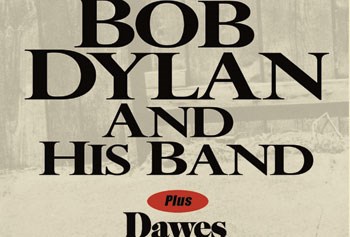Treats Crowd to New Tunes, Classics

04/11/2013
By David Perry
American storyteller and song hustler Bob Dylan returned to the shores of the Merrimack River April 9. Before a red scrim on a Tsongas Center stage, under spare lighting, Dylan spun tales of heroes and cads, of love lost and love found, and he did it from the perspective of a world-weary man who has seen much. Maybe too much.
The iconic singer-songwriter laced his 100-minute, 16-song set with the musical strains of America: stomping Chicago blues, string band tunes, swing, boogie-woogie and rock and roll.
Though he looked every inch a cool elder statesman in his wide-brimmed hat and a toreador’s stance, Dylan’s voice sounded every day of his nearly 72 years; gruff, cracked, worn and wheezy. But few ever come to Dylan for his vocal prowess and there is something fitting about this voice on these songs. Like Tom Waits and Leonard Cohen, grandpa Bob is a superb storyteller; on April 9 he put the arena crowd on his knee and wove musical yarns for nearly two hours.
Dylan’s set was vastly different from that of the evening’s opener, Los Angeles-based Dawes, whose third album hit stores on the same day as the Lowell show. The quartet’s tight vocals are sleek and their Americana sound is simple and uncluttered. Dawes’ is a sound that could have wafted out of Laurel Canyon in the early ’70s on a sweet puff of smoke. Think Eagles, think Jackson Browne, think L.A. Mafia. And think these guys were deeply flattered to be opening for Dylan.
And when the master hit the stage, it was with his crack five-piece band, growling “Things Have Changed.” The band is remarkably simpatico to Dylan’s strengths and weaknesses. In the place of Charlie Sexton on lead guitar was the great swing-blues axe man and Rhode Island native Duke Robillard. The new album by Robillard, 64, “Independently Blue,” was also released yesterday. Rounding out the band were bassist Tony Garnier, acoustic guitarist Stu Kimball, drummer George Recile and the secret weapon, steel guitarist, mandolin and banjo player Donnie Herron, who some may recall from his Lowell Folk Festival appearance with BR5-49 years ago.
The set list was peppered with fewer classics than it held during Dylan’s last Tsongas gig, in 2010. Yet Dylan did play a radically reworked “Tangled Up in Blue,” as well as “Visions of Johanna, “All Along the Watch Tower” and the encore, “Ballad of a Thin Man.” There were four cuts from his latest album, “Tempest,” and the bulk of the set list was some of his best work of the past 15 years. The new “Early Roman Kings” stomped and moaned like a vintage Muddy Waters side. Herron colored a few songs with banjo.
Dylan, ever distant, never said a word between songs. Never introduced the band. And he never picked up a guitar, preferring to plunk out chords on piano, honks harmonica lines or croon, center-stage.
Volunteers handed out a free pamphlet put together by the University to commemorate this and other Lowell Dylan shows, and business Prof. Dave Lewis shined up his 1965 VW bus and offered tours to anyone who wanted a peek inside.
The crowd ranged from young, like the girl who lugged a sign asking Dylan for a special date (“Prom?”), to the older gentleman whose view she tried not to block by hoisting it aloft. In terms of age on April 9, it was clear the middle class had been largely eliminated. The vast majority were either young newcomers to the lore of Dylan, or gray and grizzled veterans of fandom.
They all seemed to have a good time.
